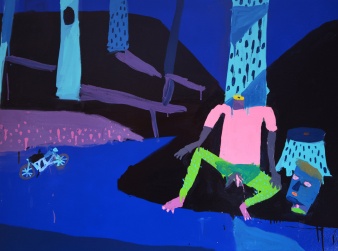Michael Howe: Bushranger, Outlaw, and Motocross champion (1814-1817)
In late October 1818 on the banks of the Shannon river, the Tasmanian bushranger Michael Howe was apprehended, clubbed to death and then beheaded. This violent event is the starting point for the painting Michael Howe: Bushranger, Outlaw, and Motocross Champion (1814-1817). In the painting the decapitated body of Michael Howe sits against a tree, his head resting on the ground and his motor bike in the river. Of course Howe was never a motocross champion and certainly never owned a motor bike, rather their presence in the painting reflects the continued impact of Australia’s colonial past.
As with my broader practice Michael Howe: Bushranger, Outlaw, and Motocross Champion (1814-1817), addresses the manner in which, representation of convict masculinity as monstrous and deviant, resonates within the performance of contemporary European Australian masculinity. The absurd incongruity of the painting foregrounds the violent and dislocating effects of a male gaze directed upon itself. Like the decapitated form of Michael Howe, contemporary heterosexual masculinity remains haunted by the spectral presence of patriarchy.
This patriarchal spectre ties Australian masculinity to a colonial past it refuses to acknowledge but is unable to forget; a refusal that has, in turn been projected onto landscapes such as the Shannon River. Both real and imagined, these spaces and habitats have become a theatre of discontent, across which, an array of cultural uncertainties play out. An endlessly repeating loop that some call history and others call fiction.
Shannon Field
2018
enamel and spray-paint

